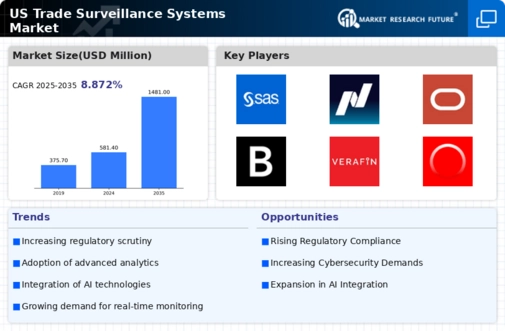Increased Regulatory Scrutiny
The trade surveillance-systems market is experiencing heightened scrutiny from regulatory bodies, which is driving demand for advanced surveillance solutions. Regulatory agencies in the US are implementing stricter compliance requirements, compelling financial institutions to adopt robust systems to monitor trading activities. This trend is underscored by the fact that fines for non-compliance have escalated, with penalties reaching billions of dollars in recent years. As a result, organizations are investing in sophisticated trade surveillance systems to ensure adherence to regulations, thereby fostering growth in the market. The increasing complexity of financial instruments and trading strategies further necessitates the deployment of advanced surveillance technologies, which are essential for detecting and preventing market abuse. Consequently, the trade surveillance-systems market is poised for significant expansion as firms seek to mitigate risks associated with regulatory violations.
Growing Focus on Risk Management
In the trade surveillance-systems market, there is an increasing emphasis on comprehensive risk management strategies. Financial institutions are recognizing the importance of proactive risk assessment to safeguard against potential losses and reputational damage. This shift is driven by the need to address various risks, including market, credit, and operational risks, which have become more pronounced in recent years. As a result, organizations are investing in trade surveillance systems that not only monitor compliance but also provide insights into risk exposure. The market for these systems is projected to grow as firms seek to implement integrated solutions that enhance their overall risk management frameworks. Additionally, the ability to conduct thorough analyses of trading activities allows firms to make informed decisions, thereby strengthening their positions in the market. Consequently, the trade surveillance-systems market is likely to expand as risk management becomes a central focus for financial institutions.
Demand for Enhanced Data Security
The trade surveillance-systems market is increasingly driven by the need for enhanced data security measures. With the rise of cyber threats and data breaches, financial institutions are prioritizing the protection of sensitive trading information. Regulatory requirements in the US mandate stringent data security protocols, compelling organizations to invest in surveillance systems that incorporate robust security features. This trend is reflected in the growing market for cybersecurity solutions, which is expected to reach $300 billion by 2025. As firms seek to safeguard their data assets, the integration of advanced encryption and access control mechanisms into trade surveillance systems becomes essential. Moreover, the potential for reputational damage and financial loss due to data breaches further underscores the importance of investing in secure surveillance solutions. Thus, the trade surveillance-systems market is likely to see sustained growth as organizations prioritize data security in their operational strategies.
Shift Towards Automated Solutions
The trade surveillance-systems market is witnessing a notable shift towards automation in surveillance processes. Financial institutions are increasingly adopting automated systems to enhance efficiency and reduce operational costs associated with manual monitoring. Automation allows for continuous surveillance of trading activities, enabling organizations to respond swiftly to potential irregularities. This trend is supported by the fact that automated systems can process large volumes of data more effectively than traditional methods. As firms aim to streamline their operations, the demand for automated trade surveillance solutions is expected to rise. Furthermore, the ability to integrate these systems with existing trading platforms enhances their functionality and effectiveness. Consequently, the trade surveillance-systems market is likely to experience growth as organizations embrace automation to improve their surveillance capabilities and ensure compliance with regulatory standards.
Technological Advancements in Analytics
The trade surveillance-systems market is significantly influenced by rapid advancements in analytics technologies. The integration of artificial intelligence (AI) and machine learning (ML) into surveillance systems enhances the ability to detect anomalies and suspicious trading patterns. These technologies enable real-time analysis of vast amounts of trading data, which is crucial for identifying potential market manipulation. According to industry estimates, the adoption of AI-driven surveillance solutions could increase operational efficiency by up to 30%. As firms strive to maintain competitive advantages, the demand for innovative analytics capabilities is likely to grow. Furthermore, the ability to adapt to evolving trading environments and regulatory requirements positions organizations favorably in the market. Thus, the trade surveillance-systems market is expected to benefit from ongoing technological innovations that improve detection accuracy and reduce false positives.

















Leave a Comment